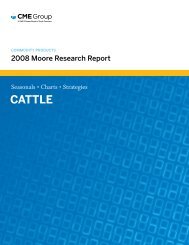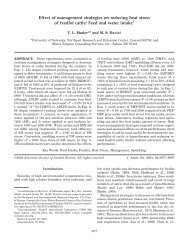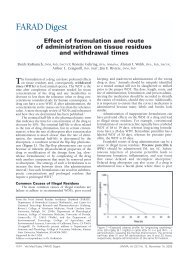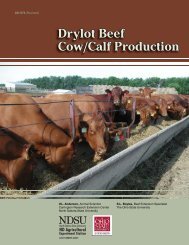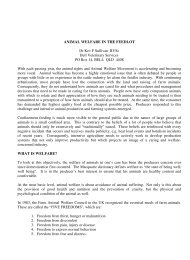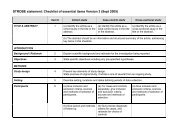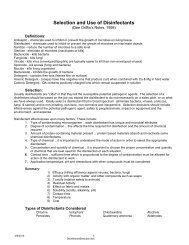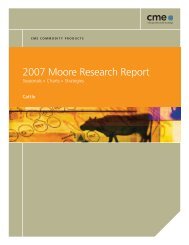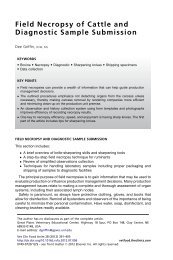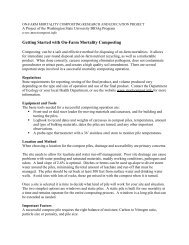How to Use an Article about Prognosis Page 1 of 6 Centre ... - gpvec
How to Use an Article about Prognosis Page 1 of 6 Centre ... - gpvec
How to Use an Article about Prognosis Page 1 of 6 Centre ... - gpvec
Create successful ePaper yourself
Turn your PDF publications into a flip-book with our unique Google optimized e-Paper software.
<strong>Centre</strong> for Health Evidence -- <strong>Use</strong>rs' Guides <strong>to</strong> Evidence-Based Practice<br />
<strong>How</strong> <strong>to</strong> <strong>Use</strong> <strong>an</strong> <strong>Article</strong> <strong>about</strong> <strong>Prognosis</strong><br />
Andreas Laupacis, George Wells, W. Scott Richardson, Peter Tugwell for the Evidence-Based Medicine Working Group<br />
Based on the <strong>Use</strong>rs' Guides <strong>to</strong> Evidence-based Medicine <strong>an</strong>d reproduced with permission from JAMA. (1994;272(3):234-237). Copyright<br />
1995, Americ<strong>an</strong> Medical Association.<br />
Clinical Scenario<br />
Search<br />
Introduction<br />
I. Are The Results Valid?<br />
II. What Are The Results?<br />
III. Will The Results Help Me In Caring For My Patients?<br />
References<br />
Clinical Scenario<br />
You are <strong>about</strong> <strong>to</strong> see a 76 year old retired school teacher for the second time. You first saw her in the clinic a month ago because <strong>of</strong> cognitive<br />
problems. Your evaluation at that time included a St<strong>an</strong>dardized Mini Mental State Examination [1], on which she scored 18 out <strong>of</strong> a possible<br />
30, <strong>an</strong>d a physical examination which was normal including no focal neurological signs. You arr<strong>an</strong>ged investigations for the treatable causes <strong>of</strong><br />
dementia which were negative, <strong>an</strong>d you thus feel she has probable Alzheimer's disease.<br />
She has lived with her son since her husb<strong>an</strong>d died six years ago. Her son thinks that she first developed signific<strong>an</strong>t problems with her memory<br />
<strong>about</strong> three years ago. <strong>How</strong>ever, she has become increasingly agitated <strong>an</strong>d par<strong>an</strong>oid during the last year. She has refused <strong>to</strong> allow him <strong>to</strong> look<br />
after her fin<strong>an</strong>cial affairs, despite the fact that she owns three pieces <strong>of</strong> property <strong>an</strong>d isn't able <strong>to</strong> m<strong>an</strong>age them herself. Her son asked you <strong>about</strong><br />
her prognosis, <strong>an</strong>d whether she is likely <strong>to</strong> die soon from the dementia. You indicated that you would discuss this with him at the second visit<br />
once the results <strong>of</strong> all the tests are available.<br />
Search<br />
Hoping <strong>to</strong> provide the son with the most specific information possible <strong>about</strong> his mother's prognosis, after the initial visit you searched the<br />
medical library's MedLine CD-ROM system via the hospital's network on the clinic computer. You entered "*Alzheimer's Disease", which<br />
yielded 3687 articles from 1990 onward. Next, you entered "prognosis", which yielded 23,004 articles; crossing the two sets yielded 27 articles.<br />
Sc<strong>an</strong>ning the abstracts on screen, you found several articles <strong>of</strong> potential interest, including one that seemed precisely on target: "Survival <strong>of</strong><br />
outpatients with Alzheimer-type dementia" by Walsh <strong>an</strong>d colleagues [2].<br />
Introduction<br />
<strong>Centre</strong> for Health Evidence: Home » <strong>Use</strong>rs' Guides <strong>to</strong> EBP<br />
In this section we will suggest a framework that you c<strong>an</strong> use <strong>to</strong> efficiently assess articles that deal with prognosis, using the report on patients<br />
with dementia as <strong>an</strong> example. We will follow the usual format <strong>of</strong> this series <strong>an</strong>d discuss how <strong>to</strong> determine whether the results are valid, how <strong>to</strong><br />
interpret the results, <strong>an</strong>d whether the information will benefit your patients (Table 1).<br />
Table: <strong>Prognosis</strong><br />
I. Are the results in the study valid?<br />
http://www.cche.net/text/usersguides/prognosis.asp<br />
<strong>Page</strong> 1 <strong>of</strong> 6<br />
3/17/2008
<strong>Centre</strong> for Health Evidence -- <strong>Use</strong>rs' Guides <strong>to</strong> Evidence-Based Practice<br />
<strong>Prognosis</strong> refers <strong>to</strong> the possible outcomes <strong>of</strong> a disease <strong>an</strong>d the frequency with which they c<strong>an</strong> be expected <strong>to</strong> occur (eg death in a patient with<br />
dementia). Sometimes the characteristics <strong>of</strong> a particular patient c<strong>an</strong> be used <strong>to</strong> more accurately predict that patient's eventual outcome (eg a<br />
patient with dementia <strong>an</strong>d behavioral problems may have a worse prognosis th<strong>an</strong> someone without behavioral problems). These characteristics<br />
are called prognostic fac<strong>to</strong>rs. Prognostic fac<strong>to</strong>rs c<strong>an</strong> be <strong>an</strong>y <strong>of</strong> several types, such as demographic (eg age), disease-specific (eg tumour stage)<br />
or comorbid (eg other conditions accomp<strong>an</strong>ying the disease in question). They c<strong>an</strong> predict <strong>an</strong>y outcome, whether good (eg cure or survival) or<br />
bad (eg death or complication). Prognostic fac<strong>to</strong>rs need not necessarily cause the outcomes, just be associated with them strongly enough <strong>to</strong><br />
predict their development. In the literature, prognostic fac<strong>to</strong>rs are usually distinguished from risk fac<strong>to</strong>rs, those patient characteristics<br />
associated with the development <strong>of</strong> the disease in the first place. For example, smoking is <strong>an</strong> import<strong>an</strong>t risk fac<strong>to</strong>r for the development <strong>of</strong> lung<br />
c<strong>an</strong>cer, but is not as import<strong>an</strong>t a prognostic fac<strong>to</strong>r as tumour stage in someone who has lung c<strong>an</strong>cer.<br />
It is usually impossible or unethical <strong>to</strong> r<strong>an</strong>domize patients <strong>to</strong> different prognostic fac<strong>to</strong>rs. Therefore the best study design <strong>to</strong> identify the<br />
presence <strong>of</strong>, <strong>an</strong>d determine the increased risk associated with a prognostic fac<strong>to</strong>r, is a cohort study. As we described in a previous article in this<br />
series [3], investiga<strong>to</strong>rs conducting a cohort study follow one or more groups (cohorts) <strong>of</strong> individuals who have not yet suffered <strong>an</strong> adverse<br />
event <strong>an</strong>d moni<strong>to</strong>r the number <strong>of</strong> outcome events over time. An ideal cohort study consists <strong>of</strong> a well defined sample <strong>of</strong> individuals<br />
representative <strong>of</strong> the population <strong>of</strong> interest, <strong>an</strong>d uses objective outcome criteria. One cohort study conducted in Framingham, in which<br />
investiga<strong>to</strong>rs have followed a cohort <strong>of</strong> 5209 individuals since 1948, has provided clinici<strong>an</strong>s with a great deal <strong>of</strong> useful information <strong>about</strong> the<br />
prognostic import<strong>an</strong>ce <strong>of</strong> m<strong>an</strong>y determin<strong>an</strong>ts <strong>of</strong> cardiovascular disease [4]. Since rigorous r<strong>an</strong>domized trials include careful documentation <strong>of</strong><br />
inclusion criteria <strong>an</strong>d strict pro<strong>to</strong>cols for follow up, patients in such trials form cohorts that c<strong>an</strong> also generate information <strong>about</strong> the prognosis <strong>of</strong><br />
a disease. <strong>How</strong>ever, the patients entered in<strong>to</strong> the trial are <strong>of</strong>ten not representative <strong>of</strong> the population with the disorder [5].<br />
To study prognostic fac<strong>to</strong>rs, investiga<strong>to</strong>rs c<strong>an</strong> also collect "cases" <strong>of</strong> individuals who have already suffered the outcome event <strong>an</strong>d compare<br />
them <strong>to</strong> "controls" who have not. In these "case-control" studies the investiga<strong>to</strong>rs count the number <strong>of</strong> individuals in each group with a<br />
particular prognostic fac<strong>to</strong>r (eg were the patients with dementia who died more likely <strong>to</strong> have had behavioral problems th<strong>an</strong> those who did not<br />
die?). The potential for bias when selecting cases <strong>an</strong>d controls, <strong>an</strong>d the retrospective nature <strong>of</strong> data collection <strong>about</strong> prognostic fac<strong>to</strong>rs (which<br />
<strong>of</strong>ten depends upon the memory <strong>of</strong> the patients or their relatives, or the accuracy <strong>of</strong> medical charts), limits the strength <strong>of</strong> inference clinici<strong>an</strong>s<br />
c<strong>an</strong> draw from case-control studies [3]. Also, case-control studies c<strong>an</strong>not provide information <strong>about</strong> the absolute risk <strong>of</strong> <strong>an</strong> event, but only<br />
<strong>about</strong> the relative risk. Nevertheless, case-control studies c<strong>an</strong> provide useful information, <strong>an</strong>d are particularly appropriate when the outcome is<br />
rare or the required duration <strong>of</strong> follow-up is long.<br />
I. Are The Results Valid?<br />
A. Primary guides<br />
Primary Guides<br />
Was there a representative <strong>an</strong>d well-defined sample <strong>of</strong> patients at a similar point in the<br />
course <strong>of</strong> the disease?<br />
Was follow-up sufficiently long <strong>an</strong>d complete?<br />
Secondary Guides<br />
Were objective <strong>an</strong>d unbiased outcome criteria used?<br />
Was there adjustment for import<strong>an</strong>t prognostic fac<strong>to</strong>rs?<br />
II. What are the results?<br />
<strong>How</strong> large is the likelihood <strong>of</strong> the outcome event(s) in a specified period <strong>of</strong> time?<br />
<strong>How</strong> precise are the estimates <strong>of</strong> likelihood?<br />
III. Will the results help me in caring for my patients?<br />
Were the study patients similar <strong>to</strong> my own?<br />
Will the results lead directly <strong>to</strong> selecting or avoiding therapy?<br />
Are the results useful for reassuring or counselling patients?<br />
1. Was there a representative <strong>an</strong>d well-defined sample <strong>of</strong> patients at a similar point in the course <strong>of</strong> the disease?<br />
This guide addresses two related issues. The first concerns how well defined the individuals in the study are, <strong>an</strong>d whether they are<br />
representative <strong>of</strong> the underlying population. The authors should describe <strong>an</strong>d specify their criteria for establishing that the patient has the<br />
disorder <strong>of</strong> interest (in this case Alzheimer-type dementia) <strong>an</strong>d how they selected their patient sample.<br />
http://www.cche.net/text/usersguides/prognosis.asp<br />
<strong>Page</strong> 2 <strong>of</strong> 6<br />
3/17/2008
<strong>Centre</strong> for Health Evidence -- <strong>Use</strong>rs' Guides <strong>to</strong> Evidence-Based Practice<br />
Several biases related <strong>to</strong> the assembly <strong>of</strong> the patients c<strong>an</strong> dis<strong>to</strong>rt the results <strong>of</strong> a study. For example, the sequence <strong>of</strong> referrals that leads patients<br />
from primary <strong>to</strong> tertiary centres raises the proportion <strong>of</strong> more severe or unusual cases, thus increasing the likelihood <strong>of</strong> adverse or nonfavourable<br />
outcomes. In one example <strong>of</strong> this "referral filter bias", the likelihood <strong>of</strong> a subsequent non-febrile seizure in children with their first<br />
febrile seizure was much lower in community-based populations th<strong>an</strong> in those drawn from hospitals [6].<br />
The second issue concerns whether the study patients are all at a similar, well-defined point in the course <strong>of</strong> their disease. Authors should<br />
provide a clear description <strong>of</strong> the stage <strong>of</strong> disease at which patients entered the study. For inst<strong>an</strong>ce, since the duration <strong>of</strong> illness is <strong>of</strong>ten<br />
associated with outcome, the investiga<strong>to</strong>rs should report the duration <strong>of</strong> illness for the sample patients. Within reason, all or most <strong>of</strong> the study<br />
patients should be at a similar point, such as survivors <strong>of</strong> a first myocardial infarction or patients newly diagnosed with lung c<strong>an</strong>cer. <strong>How</strong>ever,<br />
the similar point in the course <strong>of</strong> disease need not be early on.<br />
Walsh <strong>an</strong>d colleagues studied 126 outpatients with Alzheimer's disease who were consecutively referred <strong>to</strong> a multidisciplinary clinic for<br />
evaluation between 1980 <strong>an</strong>d 1982. The diagnosis was made by consensus by a group consisting <strong>of</strong> <strong>an</strong> internist, psychiatrist, psychologist,<br />
neurologist or neuropathologist, <strong>an</strong>d research nurse using the conventional DSM-III criteria for dementia [7]. The tests used <strong>to</strong> exclude other<br />
causes <strong>of</strong> dementia were not described. <strong>How</strong>ever, given the multidisciplinary nature <strong>an</strong>d expertise <strong>of</strong> the group, it seems reasonable <strong>to</strong> assume<br />
that the appropriate tests were done <strong>to</strong> exclude disorders such as hypothyroidism, depression <strong>an</strong>d space occupying lesions <strong>of</strong> the brain that c<strong>an</strong><br />
be confused with Alzheimer's disease.<br />
Walsh <strong>an</strong>d colleagues reported survival from two different points in time:<br />
1. referral <strong>to</strong> the clinic <strong>an</strong>d<br />
2. the point at which symp<strong>to</strong>ms <strong>of</strong> memory loss were first noticed.<br />
The former is a more certain point in time, but suffers from the disadv<strong>an</strong>tage that patients come <strong>to</strong> medical attention at different stages in the<br />
progression <strong>of</strong> their disease. The latter provides a more uniform starting point, but is potentially imprecise because dementia develops<br />
insidiously <strong>an</strong>d the time <strong>of</strong> onset is identified retrospectively. Survival after presentation <strong>to</strong> clinic is probably more relev<strong>an</strong>t for your patient's<br />
son.<br />
2. Was follow-up sufficiently long <strong>an</strong>d complete?<br />
Since the presence <strong>of</strong> a prognostic fac<strong>to</strong>r <strong>of</strong>ten precedes the development <strong>of</strong> <strong>an</strong> outcome event by a long period, investiga<strong>to</strong>rs must follow<br />
patients for long enough <strong>to</strong> detect the outcomes <strong>of</strong> interest. For example, recurrence in some women with early breast c<strong>an</strong>cer c<strong>an</strong> occur m<strong>an</strong>y<br />
years after initial diagnosis <strong>an</strong>d treatment [8]. Patients in the dementia study were enrolled between 1980 <strong>an</strong>d 1982 <strong>an</strong>d followed until 1988 or<br />
their death. Thus the follow-up was quite long, <strong>an</strong>d 61 percent <strong>of</strong> the cohort died during this time.<br />
Ideally, investiga<strong>to</strong>rs will succeed in following all patients (as they did in the dementia study) but this is <strong>of</strong>ten not the case. Patients are not<br />
usually lost <strong>to</strong> follow-up for inconsequential reasons. Patients may fail <strong>to</strong> return because they have suffered exactly those events in which the<br />
investiga<strong>to</strong>rs are interested (eg they died or have been institutionalized). Conversely, patients who feel entirely healthy may also be less likely<br />
<strong>to</strong> return for evaluation because they feel so well. Simply put, the greater the number <strong>of</strong> patients lost <strong>to</strong> follow-up, the less accurate the estimate<br />
regarding the risk <strong>of</strong> the adverse outcome.<br />
Under what circumst<strong>an</strong>ces does loss <strong>to</strong> follow-up compromise the validity <strong>of</strong> a study? It is import<strong>an</strong>t that you consider the relation between the<br />
proportion <strong>of</strong> patients who are lost <strong>an</strong>d the proportion <strong>of</strong> patients who have suffered the adverse outcome <strong>of</strong> interest. The larger the number <strong>of</strong><br />
patients whose fate is unknown relative <strong>to</strong> the number who have suffered <strong>an</strong> event, the greater the threat <strong>to</strong> the study's validity. For inst<strong>an</strong>ce, let<br />
us assume that 30% <strong>of</strong> a particularly high risk group (such as elderly diabetics) have suffered <strong>an</strong> adverse outcome (such as cardiovascular<br />
death) during long-term follow-up. If 5% <strong>of</strong> the patients have been lost, the true rate <strong>of</strong> patients who had died may be as high as 35%. Even<br />
were this so, the clinical implications would not ch<strong>an</strong>ge, <strong>an</strong>d the loss <strong>to</strong> follow-up doesn't threaten the validity <strong>of</strong> the study. <strong>How</strong>ever, in a much<br />
lower-risk patient sample (otherwise healthy middle-aged men, for inst<strong>an</strong>ce) the observed event rate may be 1%. In this case, if one assumed<br />
that all 5% <strong>of</strong> the patients lost <strong>to</strong> follow-up had died, the event rate <strong>of</strong> 6% would have very different implications. If the number <strong>of</strong> patients lost<br />
potentially jeopardizes the study's validity, you should look for the reasons for patients being lost, <strong>an</strong>d compare the import<strong>an</strong>t demographic <strong>an</strong>d<br />
clinical characteristics <strong>of</strong> the patients who were lost <strong>to</strong> the patients in whom follow-up was complete. To the extent that the reasons for<br />
disappear<strong>an</strong>ce are unrelated <strong>to</strong> outcome, <strong>an</strong>d the patients who are lost are similar <strong>to</strong> those for whom information is complete, you may feel<br />
reassured. If investiga<strong>to</strong>rs omit information <strong>about</strong> reasons for loss <strong>to</strong> follow-up, or the characteristics <strong>of</strong> the patients who are lost, the strength<br />
<strong>of</strong> inference from the study results will be weaker.<br />
B. Secondary Guides<br />
1. Were objective <strong>an</strong>d unbiased outcome criteria used?<br />
<strong>Page</strong> 3 <strong>of</strong> 6<br />
Investiga<strong>to</strong>rs must provide a clear <strong>an</strong>d sensible definition <strong>of</strong> adverse outcomes before the study starts. Outcome events c<strong>an</strong> vary from those that<br />
are objective <strong>an</strong>d easily measured (death), <strong>to</strong> those which require some judgement (myocardial infarction), <strong>to</strong> those that require considerable<br />
http://www.cche.net/text/usersguides/prognosis.asp<br />
3/17/2008
<strong>Centre</strong> for Health Evidence -- <strong>Use</strong>rs' Guides <strong>to</strong> Evidence-Based Practice<br />
judgement, <strong>an</strong>d may <strong>of</strong>ten be difficult <strong>to</strong> measure (eg disability, quality <strong>of</strong> life). To minimize bias, the individual determining the outcomes<br />
should not know whether the patient had a potential prognostic fac<strong>to</strong>r. This is not always possible, <strong>an</strong>d for unequivocal events such as death<br />
may not be necessary. <strong>How</strong>ever, blinding is essential for outcomes requiring a great deal <strong>of</strong> judgement, such as tr<strong>an</strong>sient ischemic attacks, or<br />
unstable <strong>an</strong>gina. In Walsh's study, the method <strong>an</strong>d intensity <strong>of</strong> follow-up was not described. <strong>How</strong>ever, all patients were accounted for at the end<br />
<strong>of</strong> the study, <strong>an</strong>d the date <strong>of</strong> death was known in those who died.<br />
2. Was there adjustment for import<strong>an</strong>t prognostic fac<strong>to</strong>rs?<br />
When comparing the prognosis <strong>of</strong> two groups <strong>of</strong> patients, investiga<strong>to</strong>rs should consider whether their clinical characteristics are similar, <strong>an</strong>d<br />
adjust the <strong>an</strong>alysis for <strong>an</strong>y differences they find. The Framingham study investiga<strong>to</strong>rs reported that the rate <strong>of</strong> stroke in patients with atrial<br />
fibrillation <strong>an</strong>d rheumatic heart disease was 41 per 1000 person-years, which was very similar <strong>to</strong> the rate for patients with atrial fibrillation but<br />
no rheumatic heart disease [9]. <strong>How</strong>ever, patients with rheumatic heart disease were younger th<strong>an</strong> those who did not have rheumatic heart<br />
disease. Once adjustments were made for the age, gender <strong>an</strong>d hypertensive status <strong>of</strong> the patients, the investiga<strong>to</strong>rs found that the rate <strong>of</strong> stroke<br />
was 6 fold greater in patients with rheumatic heart disease <strong>an</strong>d atrial fibrillation th<strong>an</strong> in patients with atrial fibrillation who did not have<br />
rheumatic heart disease.<br />
M<strong>an</strong>y studies <strong>of</strong> prognosis break the study group in<strong>to</strong> cohorts based on suspected prognostic fac<strong>to</strong>rs. Comparison <strong>of</strong> the pattern <strong>an</strong>d frequencies<br />
<strong>of</strong> outcomes between these groups c<strong>an</strong> determine the relative risk associated with the prognostic fac<strong>to</strong>r in question. For example, Pincus <strong>an</strong>d<br />
colleagues followed a cohort <strong>of</strong> patients with rheuma<strong>to</strong>id arthritis for 15 years [10]. They separated the patients in<strong>to</strong> a number <strong>of</strong> cohorts<br />
depending upon their demographic characteristics, disease variables <strong>an</strong>d functional status. They found that some demographic variables (eg age<br />
<strong>an</strong>d education level) <strong>an</strong>d functional status (eg modified walking time <strong>an</strong>d activities <strong>of</strong> daily living) were strongly predictive <strong>of</strong> mortality.<br />
Since treatments c<strong>an</strong> also alter patient outcomes, they should be taken in<strong>to</strong> account when <strong>an</strong>alyzing prognostic fac<strong>to</strong>rs. While such treatments<br />
are not, strictly speaking, prognostic fac<strong>to</strong>rs, the investiga<strong>to</strong>rs should adjust for differences in treatment in the <strong>an</strong>alysis. For example, in a study<br />
from Framingham which examined the prognosis <strong>of</strong> Q-wave versus non-Q-wave first myocardial infarction, the investiga<strong>to</strong>rs adjusted for age,<br />
sex, <strong>an</strong>d the presence <strong>of</strong> hypertension, <strong>an</strong>gina pec<strong>to</strong>ris, congestive heart failure, <strong>an</strong>d cardiovascular disease prior <strong>to</strong> the infarct [11]. <strong>How</strong>ever,<br />
they did not take in<strong>to</strong> account treatment with aspirin or beta-blockers which clinici<strong>an</strong>s may have administered at the time <strong>of</strong> the infarct, <strong>an</strong>d<br />
which we know have <strong>an</strong> impact on mortality.<br />
In the study by Walsh <strong>an</strong>d colleagues, no attempt was made <strong>to</strong> compare the mortality rate <strong>of</strong> the demented patients with a group <strong>of</strong> patients<br />
without dementia. <strong>How</strong>ever, they did evaluate the import<strong>an</strong>ce <strong>of</strong> 20 potential prognostic fac<strong>to</strong>rs in their cohort. Age at symp<strong>to</strong>m onset,<br />
dementia severity, w<strong>an</strong>dering <strong>an</strong>d falling, behavioral problems, <strong>an</strong>d hearing loss all had a statistically signific<strong>an</strong>t relation <strong>to</strong> mortality.<br />
II. What Are The Results?<br />
The qu<strong>an</strong>titative results from studies <strong>of</strong> prognosis or risk are the number <strong>of</strong> events that occur over time. We will describe three common<br />
expressions <strong>of</strong> this relationship that provide complementary information <strong>about</strong> prognosis.<br />
1. <strong>How</strong> large is the likelihood <strong>of</strong> the outcome event(s) in a specified period <strong>of</strong> time?<br />
<strong>Page</strong> 4 <strong>of</strong> 6<br />
Your patient's son asked "What are the ch<strong>an</strong>ces that my mother will still be alive in five years?". You c<strong>an</strong> provide a simple <strong>an</strong>d direct <strong>an</strong>swer in<br />
absolute terms. Five years after presentation <strong>to</strong> the clinic <strong>about</strong> one half the patients (50%) had died. Thus there is <strong>about</strong> a 50:50 ch<strong>an</strong>ce that his<br />
mother will be alive in five years.<br />
Your patient's son might then indicate that the only person he knows with Alzheimer's disease is a 65 year old uncle who was diagnosed 10<br />
years ago <strong>an</strong>d is still living. He is surprised that his mother's ch<strong>an</strong>ce <strong>of</strong> dying in the next five years is so high. This gives you the ch<strong>an</strong>ce <strong>to</strong><br />
discuss some <strong>of</strong> the prognostic fac<strong>to</strong>rs for death in patients with Alzheimer's disease. As mentioned previously, the statistically signific<strong>an</strong>t<br />
prognostic fac<strong>to</strong>rs for death were increasing age, dementia severity, behavioral problems, <strong>an</strong>d hearing loss. You explain that his mother is<br />
considerably older th<strong>an</strong> his uncle was at the time <strong>of</strong> diagnosis, <strong>an</strong>d that this likely explains some <strong>of</strong> the difference. It would be nice <strong>to</strong> use the<br />
prognostic fac<strong>to</strong>rs <strong>to</strong> further refine the ch<strong>an</strong>ce <strong>of</strong> death in his mother. Her age is almost identical <strong>to</strong> the me<strong>an</strong> age <strong>of</strong> the cohort studied by Walsh<br />
<strong>an</strong>d colleagues. <strong>How</strong>ever, her Mini Mental State Examination score is quite low (indicating more severe dementia) <strong>an</strong>d her behavioral<br />
problems also suggest that she is at higher risk th<strong>an</strong> the average patient in Walsh's study. Unfortunately, no table or formula was presented<br />
which allows you <strong>to</strong> combine all <strong>of</strong> these fac<strong>to</strong>rs <strong>an</strong>d estimate a risk <strong>of</strong> mortality that is specific for your patient. <strong>How</strong>ever, you c<strong>an</strong> feel<br />
confident in telling her son that his mother's ch<strong>an</strong>ces <strong>of</strong> dying are at least 50% during the next five years, <strong>an</strong>d probably greater.<br />
The son might then ask whether his mother's ch<strong>an</strong>ces <strong>of</strong> survival ch<strong>an</strong>ge with time. Neither the absolute nor relative expressions <strong>of</strong> results<br />
address this question. For this <strong>an</strong>swer we should turn <strong>to</strong> a survival curve, a graph <strong>of</strong> the number <strong>of</strong> events over time (or conversely, the ch<strong>an</strong>ce<br />
<strong>of</strong> being free <strong>of</strong> these events over time) [12]. The events must be discrete (eg death, stroke, recurrence <strong>of</strong> c<strong>an</strong>cer) <strong>an</strong>d the time at which they<br />
occur must be precisely known. In most clinical situations the ch<strong>an</strong>ce <strong>of</strong> <strong>an</strong> outcome ch<strong>an</strong>ges with time. Figure 1 shows two survival curves,<br />
one <strong>of</strong> survival after a myocardial infarction [3] <strong>an</strong>d the other the results <strong>of</strong> hip replacement surgery [14]. Note that the ch<strong>an</strong>ce <strong>of</strong> dying after a<br />
myocardial infarction is highest shortly after the event (reflected by <strong>an</strong> initially steep slope <strong>of</strong> the curve which then flattens), while very few hip<br />
http://www.cche.net/text/usersguides/prognosis.asp<br />
3/17/2008
<strong>Centre</strong> for Health Evidence -- <strong>Use</strong>rs' Guides <strong>to</strong> Evidence-Based Practice<br />
replacements require revision until much later (this curve starts out flat <strong>an</strong>d then steepens). Walsh <strong>an</strong>d colleagues provided a survival curve in<br />
their Figure 1 that suggests that the ch<strong>an</strong>ce <strong>of</strong> dying is more or less const<strong>an</strong>t during the first seven years after referral <strong>to</strong> the clinic for dementia.<br />
2. <strong>How</strong> precise are the estimates <strong>of</strong> likelihood?<br />
Even when valid, a prognostic study provides only <strong>an</strong> estimate <strong>of</strong> the true risk. After determining the size <strong>of</strong> the risk, we should next examine<br />
the precision <strong>of</strong> the estimate, which is best done with a confidence interval. Walsh <strong>an</strong>d colleagues found that the 95% confidence interval for<br />
survival five years after presentation was approximately 39 <strong>to</strong> 58% (extrapolated from Figure 1 in their article). Note that in most survival<br />
curves the earlier follow-up periods usually include results from more patients th<strong>an</strong> the later periods (due <strong>to</strong> losses <strong>to</strong> follow-up <strong>an</strong>d because<br />
patients are not enrolled in<strong>to</strong> the study at the same time). This me<strong>an</strong>s that the survival curves are more precise in the earlier periods, indicated<br />
by narrower confidence b<strong>an</strong>ds around the left-h<strong>an</strong>d parts <strong>of</strong> the curve.<br />
Walsh <strong>an</strong>d colleagues also provided 95% confidence intervals for the relative risk associated with each prognostic fac<strong>to</strong>r. For example, the<br />
relative risk associated with a behavioral problem was 1.5 with a 95% confidence interval <strong>of</strong> 1.0 <strong>to</strong> 2.5. This me<strong>an</strong>s that the best estimate is that<br />
a patient with a behavioral problem is 1.5 times more likely <strong>to</strong> die th<strong>an</strong> <strong>an</strong> individual without a behavioral problem. The probability that the true<br />
relative risk is between 1.0 (ie no effect) <strong>an</strong>d 2.5 is 95%.<br />
III. Will The Results Help Me In Caring For My Patients?<br />
1. Were the study patients similar <strong>to</strong> my own?<br />
<strong>How</strong> well do the study results generalize <strong>to</strong> the patients in your practice? The authors should describe the study patients in enough detail <strong>to</strong><br />
allow comparison with your patients. The article should list the patients' import<strong>an</strong>t clinical characteristics, along with the definitions used for<br />
these characteristics. The closer the match between the patient before you <strong>an</strong>d those in the study, the more confident you c<strong>an</strong> be in applying the<br />
study results <strong>to</strong> that patient. The characteristics <strong>of</strong> the study patients were quite similar <strong>to</strong> your patient.<br />
2. Will the results lead directly <strong>to</strong> selecting or avoiding therapy?<br />
Since there are no therapies for dementia that are routinely available <strong>an</strong>d clearly effective, this guide does not directly apply <strong>to</strong> your patient.<br />
<strong>How</strong>ever, prognostic data <strong>of</strong>ten provide the basis for sensible decisions <strong>about</strong> therapy. Knowing the expected clinical course <strong>of</strong> your patient's<br />
condition c<strong>an</strong> help you judge whether treatment should be <strong>of</strong>fered at all. For example, warfarin markedly decreases the risk <strong>of</strong> stroke in patients<br />
with non-rheumatic atrial fibrillation, <strong>an</strong>d is indicated for m<strong>an</strong>y patients with this disorder [15]. <strong>How</strong>ever, in one study the frequency <strong>of</strong> stroke<br />
in patients with "lone" atrial fibrillation (patients 60 years <strong>of</strong> age or younger with no associated cardiopulmonary disorders) was 1.3% over 15<br />
years [16]. The risks <strong>of</strong> long-term warfarin therapy in this group <strong>of</strong> patients probably outweigh the benefits.<br />
3. Are the results useful for reassuring or counselling patients?<br />
Even if the prognostic result does not lead you <strong>to</strong> prescribe <strong>an</strong> effective therapy, it c<strong>an</strong> still be clinically useful. A valid, precise <strong>an</strong>d<br />
generalizable result <strong>of</strong> uniformly good prognosis is very helpful <strong>to</strong> the clinici<strong>an</strong> when reassuring a concerned patient or relative. Some<br />
conditions, such as asymp<strong>to</strong>matic hiatal hernia or asymp<strong>to</strong>matic colonic diverticulae, have such a good overall prognosis that they have been<br />
termed "nondisease" [17]. On the other h<strong>an</strong>d, a prognostic result <strong>of</strong> uniformly bad prognosis provides the clinici<strong>an</strong> with a starting place for a<br />
discussion with the patient <strong>an</strong>d family, leading <strong>to</strong> counselling <strong>about</strong> end-<strong>of</strong>-life concerns.<br />
In your patient, information on the likelihood <strong>of</strong> death will be useful <strong>to</strong> the son <strong>an</strong>d his family as they pl<strong>an</strong> the future care <strong>of</strong> his mother. Of<br />
course other prognostic information <strong>about</strong> the rate <strong>of</strong> progression <strong>of</strong> the dementing process <strong>an</strong>d the need for intensive nursing care would be<br />
also be useful [18] [19].<br />
References<br />
<strong>Page</strong> 5 <strong>of</strong> 6<br />
1. Molloy DW, Alemayehu E, Roberts R. Reliability <strong>of</strong> a st<strong>an</strong>dardized mini-mental state examination compared with the traditional minimental<br />
state examination. Am J Psychiatry 148. 102-5 (1991).<br />
2. Walsh JS, Welch G, Larson EB, Welch HG. Survival <strong>of</strong> outpatients with Alzheimer-type dementia. Ann Intern Med 113. 429-34 (1990).<br />
3. Levine MS, Walter SS, Lee HN, Haines T, Holbrook A, Moyer V. <strong>Use</strong>rs' guides <strong>to</strong> the medical literature: IV. <strong>How</strong> <strong>to</strong> use <strong>an</strong> article <strong>about</strong><br />
harm. Evidence-Based Medicine Working Group. J A M A 271. 1615-9 (1994).<br />
http://www.cche.net/text/usersguides/prognosis.asp<br />
3/17/2008
<strong>Centre</strong> for Health Evidence -- <strong>Use</strong>rs' Guides <strong>to</strong> Evidence-Based Practice<br />
4. Dawber TR, K<strong>an</strong>nel WB, Lyell LP. An approach <strong>to</strong> longitudinal studies in a community: The Framingham study. Ann N Y Acad Sci 107.<br />
539(1963).<br />
5. Bennett JC. Inclusion <strong>of</strong> women in clinical trials - policies for population subgroups. N Engl J Med 329. 288-92 (1993).<br />
6. Ellenberg JH, Nelson KB. Sample selection <strong>an</strong>d the natural selection <strong>of</strong> disease. Studies <strong>of</strong> febrile seizures. J A M A 243. 1337-40 (1980).<br />
7. Americ<strong>an</strong> Psychiatric Association Task Force. Task force on nomenclature <strong>an</strong>d statistics: diagnostic <strong>an</strong>d statistical m<strong>an</strong>ual <strong>of</strong> mental<br />
disorders.(1980) Third.Washing<strong>to</strong>n, D.C. Americ<strong>an</strong> Psychiatric Association.<br />
8. Early Breast C<strong>an</strong>cer Trialists' Collaborative Group, Anonymous. Systemic treatment <strong>of</strong> early breast c<strong>an</strong>cer by hormonal, cy<strong>to</strong><strong>to</strong>xic, or<br />
immune therapy. 133 r<strong>an</strong>domised trials involving 31000 recurrences <strong>an</strong>d 24000 deaths among 75000 women. Early Breast C<strong>an</strong>cer Trialists'<br />
Collaborative Group. L<strong>an</strong>cet 339. 1-15 (1992).<br />
9. Wolf PA, Dawber TR, Thomas HE, K<strong>an</strong>nel WB, Thomas HE, Jr. Epidemiologic assessment <strong>of</strong> chronic atrial fibrillation <strong>an</strong>d risk <strong>of</strong> stroke:<br />
the Framingham study. Neurology 28. 973-7 (1978).<br />
10. Pincus T, Brooks RH, Callah<strong>an</strong> LF. Prediction <strong>of</strong> long-term mortality in patients with rheuma<strong>to</strong>id arthritis according <strong>to</strong> simple<br />
questionnaire <strong>an</strong>d joint count measures. Ann Intern Med 120. 26-34 (1994).<br />
11. Berger CJ, Murabi<strong>to</strong> JM, Ev<strong>an</strong>s JC, et al, Anderson KM, Levy D. <strong>Prognosis</strong> after first myocardial infarction. Comparison <strong>of</strong> Q- wave <strong>an</strong>d<br />
non-Q-wave myocardial infarction in the Framingham Heart Study. J A M A 268. 1545-51 (1992).<br />
12. Katz MH, Hauck WW. Proportional hazards (Cox) regression Proportional hazards (Cox) regression. J Gen Intern Med 8. 702-11 (1993).<br />
13. ISIS-2 (Seocnd International Study <strong>of</strong> Infarct Survival) Collaborative Group, Anonymous. R<strong>an</strong>domised trial <strong>of</strong> intravenous strep<strong>to</strong>kinase,<br />
oral aspirin, both, or neither among 17,187 cases <strong>of</strong> suspected acute myocardial infarction: ISIS-2. ISIS-2 (Second International Study <strong>of</strong><br />
Infarct Survival) Collaborative Group. L<strong>an</strong>cet 2. 349-60 (1988).<br />
14. Dorey F, Amstutz H, Amstutz HC. The validity <strong>of</strong> survivorship <strong>an</strong>alysis in <strong>to</strong>tal joint arthroplasty. J Bone J Surg 71. 544-8 (1989).<br />
15. Laupacis A, Albers G, Dunn M, Feinberg W, Dalen J, Jacobson A. Antithrombotic therapy in atrial fibrillation. Chest 108. 352S-9S (1995).<br />
16. Kopecky SL, Gersh BJ, McGoon MD, Whisn<strong>an</strong>t JP, Holmes DR, Jr., Ilstrup DM, Frye RL. The natural his<strong>to</strong>ry <strong>of</strong> lone atrial fibrillation. A<br />
population-based study over three decades. N Engl J Med 317. 669-74 (1987).<br />
17. Meador CK. The art <strong>an</strong>d science <strong>of</strong> nondisease. N Engl J Med : 272-92 (1965).<br />
18. Stern Y, Mayeux R, Hauswer WA, Bush R, S<strong>an</strong>o M, Hauser WA, Bush T. Predic<strong>to</strong>rs <strong>of</strong> disease course in patients with probable<br />
Alzheimer's disease. Neurology 37. 1649-53 (1987).<br />
19. Drachm<strong>an</strong> DA, O'Donnell BF, Lew RA, Swearer JM. The prognosis in Alzheimer's Disease. "<strong>How</strong> far" rather th<strong>an</strong> "how fast" best predicts<br />
the course. Arch Neurol 47. 851-6 (1990).<br />
http://www.cche.net/text/usersguides/prognosis.asp<br />
© 2001 <strong>Centre</strong> for Health Evidence.<br />
Home. <strong>Use</strong>rs' Guides <strong>to</strong> EBP. Webmaster. Disclaimer.<br />
<strong>Page</strong> 6 <strong>of</strong> 6<br />
3/17/2008




